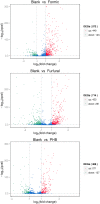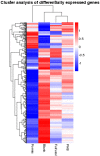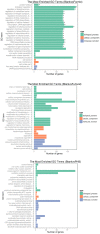Effects of Inhibitors on the Transcriptional Profiling of Gluconobater oxydans NL71 Genes after Biooxidation of Xylose into Xylonate
- PMID: 28487685
- PMCID: PMC5403930
- DOI: 10.3389/fmicb.2017.00716
Effects of Inhibitors on the Transcriptional Profiling of Gluconobater oxydans NL71 Genes after Biooxidation of Xylose into Xylonate
Abstract
D-Xylonic acid belongs to the top 30 biomass-based platform chemicals and represents a promising application of xylose. Until today, Gluconobacter oxydans NL71 is the most efficient microbe capable of fermenting xylose into xylonate. However, its growth is seriously inhibited when concentrated lignocellulosic hydrolysates are used as substrates due to the presence of various degraded compounds formed during biomass pretreatment. Three critical lignocellulosic inhibitors were thereby identified, i.e., formic acid, furfural, and 4-hydroxybenzaldehyde. As microbe fermentation is mostly regulated at the genome level, four groups of cell transcriptomes were obtained for a comparative investigation by RNA sequencing of a control sample with samples treated separately with the above-mentioned inhibitors. The digital gene expression profiles screened 572, 714 genes, and 408 DEGs was obtained by the comparisons among four transcriptomes. A number of genes related to the different functional groups showed characteristic expression patterns induced by three inhibitors, in which 19 genes were further tested and confirmed by qRT-PCR. We extrapolated many differentially expressed genes that could explain the cellular responses to the inhibitory effects. We provide results that enable the scientific community to better define the molecular processes involved in the microbes' responses to lignocellulosic inhibitors during the cellular biooxidation of xylose into xylonic acid.
Keywords: Gluconobacter oxydans; lignocellulosic inhibitor; responsible gene; transcriptome sequencing; xylonate; xylose.
Figures





Similar articles
-
Enhancement of Gluconobacter oxydans Resistance to Lignocellulosic-Derived Inhibitors in Xylonic Acid Production by Overexpressing Thioredoxin.Appl Biochem Biotechnol. 2020 Jul;191(3):1072-1083. doi: 10.1007/s12010-020-03253-6. Epub 2020 Jan 20. Appl Biochem Biotechnol. 2020. PMID: 31960365
-
Screening of Gluconobacter oxydans in xylonic acid fermentation for tolerance of the inhibitors formed dilute acid pretreatment.Bioprocess Biosyst Eng. 2023 Apr;46(4):589-597. doi: 10.1007/s00449-023-02845-w. Epub 2023 Jan 20. Bioprocess Biosyst Eng. 2023. PMID: 36670301
-
Draft Genome Sequence of Gluconobacter oxydans NL71, a Strain That Efficiently Biocatalyzes Xylose to Xylonic Acid at a High Concentration.Genome Announc. 2015 Jun 18;3(3):e00615-15. doi: 10.1128/genomeA.00615-15. Genome Announc. 2015. PMID: 26089417 Free PMC article.
-
Microbial D-xylonate production.Appl Microbiol Biotechnol. 2012 Oct;96(1):1-8. doi: 10.1007/s00253-012-4288-5. Epub 2012 Aug 9. Appl Microbiol Biotechnol. 2012. PMID: 22875400 Free PMC article. Review.
-
Genetic improvement of native xylose-fermenting yeasts for ethanol production.J Ind Microbiol Biotechnol. 2015 Jan;42(1):1-20. doi: 10.1007/s10295-014-1535-z. Epub 2014 Nov 18. J Ind Microbiol Biotechnol. 2015. PMID: 25404205 Review.
Cited by
-
Efficient aerobic fermentation of gluconic acid by high tension oxygen supply strategy with reusable Gluconobacter oxydans HG19 cells.Bioprocess Biosyst Eng. 2022 Nov;45(11):1849-1855. doi: 10.1007/s00449-022-02791-z. Epub 2022 Sep 23. Bioprocess Biosyst Eng. 2022. PMID: 36149483
-
Highly efficient fermentation of 5-keto-D-fructose with Gluconobacter oxydans at different scales.Microb Cell Fact. 2022 Dec 10;21(1):255. doi: 10.1186/s12934-022-01980-5. Microb Cell Fact. 2022. PMID: 36496372 Free PMC article.
-
Overexpression of mGDH in Gluconobacter oxydans to improve D-xylonic acid production from corn stover hydrolysate.Microb Cell Fact. 2022 Mar 9;21(1):35. doi: 10.1186/s12934-022-01763-y. Microb Cell Fact. 2022. PMID: 35264166 Free PMC article.
-
Engineering of glycerol utilization in Gluconobacter oxydans 621H for biocatalyst preparation in a low-cost way.Microb Cell Fact. 2018 Oct 8;17(1):158. doi: 10.1186/s12934-018-1001-0. Microb Cell Fact. 2018. PMID: 30296949 Free PMC article.
-
Osmotic stress tolerance and transcriptome analysis of Gluconobacter oxydans to extra-high titers of glucose.Front Microbiol. 2022 Aug 12;13:977024. doi: 10.3389/fmicb.2022.977024. eCollection 2022. Front Microbiol. 2022. PMID: 36033857 Free PMC article.
References
-
- Adachi O., Ano Y., Toyama H., Matsushita K. (2007). Chapter 1: Biooxidation with PQQ- and FAD-dependent dehydrogenases, in Modern Biooxidation: Enzymes, Reactions and Applications, eds Schmid R. D., Urlacher V. B. (Weinheim: Wiley-VCH; ), 1–41.
-
- Asai T., Iizuka H., Komagata K. (1964). The flagellation and taxonomy of genera Gluconobacter and Acetobacter with reference to the existence of intermediate strains. J. Gen. Appl. Microbiol. 10, 95–125. 10.2323/jgam.10.95 - DOI
-
- Benjamini Y., Hochberg Y. (1995). Controlling the false discovery rate: a practical and powerful approach to multiple testing. J. R. Stat. Soc. Ser. B (Methodol). 57, 289–300.
LinkOut - more resources
Full Text Sources
Other Literature Sources
Molecular Biology Databases
Research Materials

